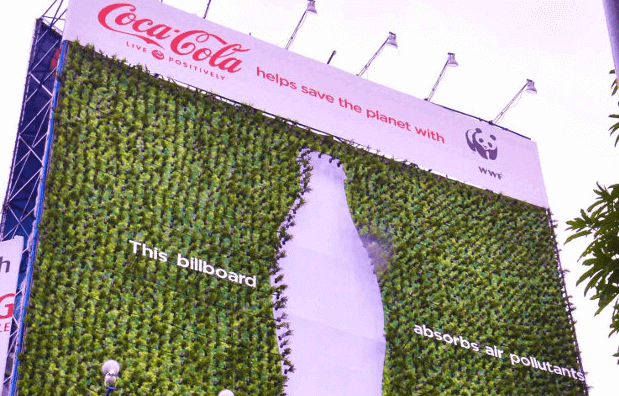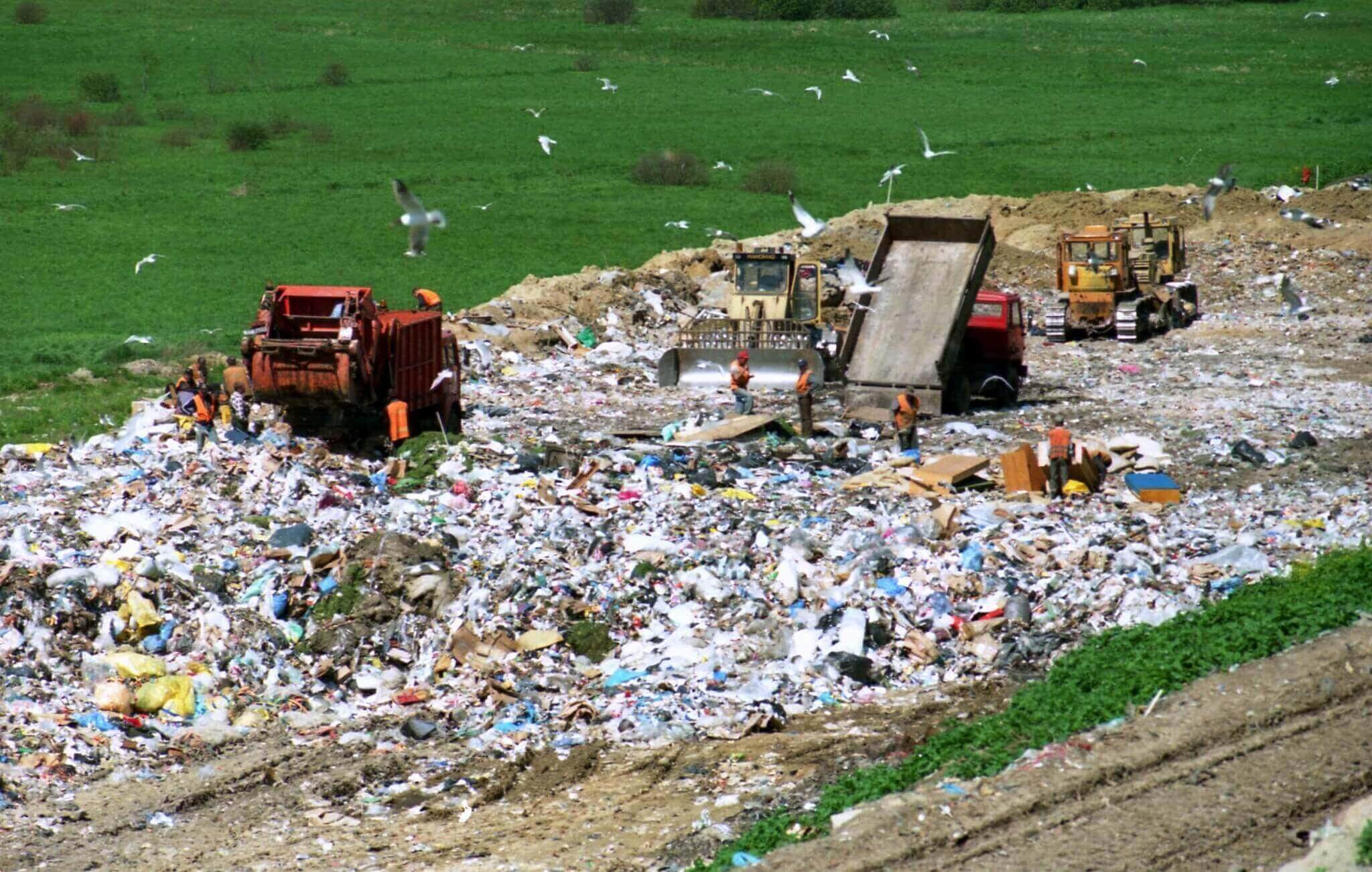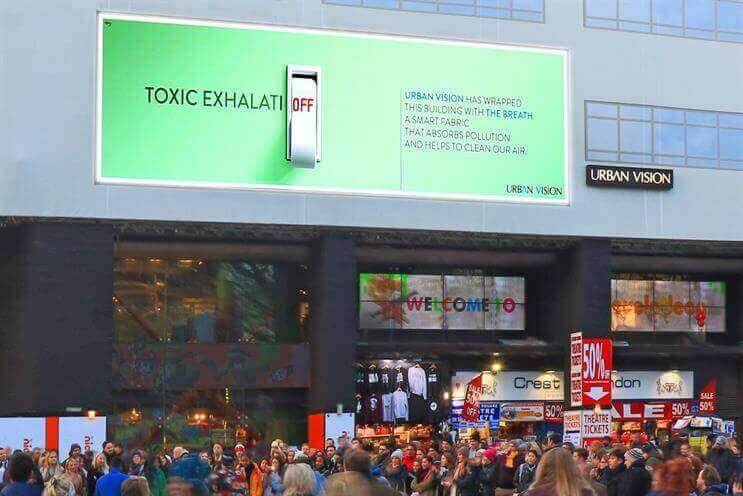
The global landscape is evolving toward a more sustainable future, characterized by eco-friendly practices. As climate change concerns continue to rise in recent years, consumers are increasingly embracing environmentally responsible choices. This shift places businesses that prioritize environmental protection and sustainability in a favorable position, as they gain more recognition, trust, and financial support from the general public.
The State of Green Business 2019 report states that 85% of S&P 500 companies published a sustainability report in 2017, highlighting their sustainability goals and renewable energy policies. With varying deadlines, dozens have even pledged to power their operations with 100% renewable energy.
This article outlines the ways in which the marketing world – specifically the out-of-home marketing world – is leveraging sustainable out-of-home advertisements to support the green movement and promote companies as environmentally responsible members of society – a change that can give any business a competitive advantage when it comes to trust, image, and profits.
Why businesses are making the turn to sustainable practices
On both local and global scales, sustainability is demanding attention from business owners, stakeholders, and consumers.
Companies which place importance on their environmental impact are likely to see increases in profits, the attraction of more talent, and the development of a differentiated and respected brand.

Image source : google
Increases in profits
While the use of sustainable and eco-friendly products is a red flag to most business owners as they only see increased expenses they can’t afford on their tight budget, new research is showing that the promotion of environmentally-friendly products actually increases demand substantially, off-setting the increased costs and bringing businesses higher profits.
The Business and Sustainable Development Commission reported that they estimate that businesses worldwide could realize $12 trillion in savings by 2030 by adopting measures that improve sustainability by reducing carbon consumption. Additionally, 21% of those surveyed claimed that they would support brands that clearly conveyed the sustainability aspects of their products through their marketing and packaging.
Now, in 2019, this importance on the environment has grown even larger: across all industries, there is an increasing demand for eco-friendly, natural, and socially responsible products through businesses that focus on green and sustainable practices. In 2019, the Nielsen global online survey identified 66 percent of its worldwide study respondents stated they were committed to eco-friendly products, services, and businesses, stating they would pay more for a product consisting of sustainable sources.
For business owners, this means that their increased expenses are worth their while; customers are willing to pay more, and more often for products that support the fight for environmental protection.
Not only do eco-friendly practices lead to increased profits, but they lead to legal and tax advantages. While these advantages vary by specific region, these incentives provide a relatively high pay-off and can offset the costs of producing sustainable products and maintaining sustainable practices.
The attraction (and retention) of employees
Because of the attention being placed on environmental practices, more and more people are becoming concerned with the implications of their everyday activities – even including the workplace. According to research conducted by The Guardian, 42% of the modern workforce wants to work for an organization that has a positive impact on the world.

Image source : google
Leading this wave of green employees are millennials. Per the Stanford Social Innovation Review, 88% of business school students believe that environmental and social issues are priorities in order to succeed in business.
Not only do sustainable practices attract employees, but sustainable practices help employees. Studies show that building occupants in high-performing, green-certified office environments “scored 26% higher on tests of cognitive function and had 30% fewer sickness syndromes.”
The development of the brand and a positive image
Consumers, employees, and investors are all increasingly embracing companies they view as innovative pacesetters with clear visions for the future, prioritizers of long-term investment strategies, and hallmarks of corporate social responsibility – the implementation of sustainable practices is one way of establishing your company as checking all three of these boxes.
The implementation of eco-friendly practices and it’s communication to the public can create an impressive image for your business, differentiating you from the competition, and giving you a clear competitive advantage in a crowded market. A study by Nielson found that 21% of all people polled would support brands that clearly conveyed the sustainability aspects of their products through their marketing and packaging.
In fact, the majority of consumers – including 78% of shoppers in the U.S. – report positive feelings when they purchase sustainable products.
How the OOH advertising industry is taking the turn to sustainability

Image source : google
Sustainable print-OOH billboards
In the past, the use of materials such as single-use paper and vinyl have translated into a large amount of landfill waste from the advertising industry – approximately 300,000 billboards in the U.S. each year produce hundreds of thousands of pounds of vinyl waste. Because of this inability to reuse or recycle the traditional PVC vinyl banners nor paper billboard materials, and the high turnover rate of out-of-home advertisements, advertising companies have been forced to contribute greatly to the amount of waste in landfills — an irresponsible and expensive practice.

To combat their past, the out-of-home advertising industry has created substitutes and developed methods of using renewable energy over recent years in order to create sustainable out-of-home advertising practices.
Circle Graphics, a Colorado-based company, developed a new product named Eco-Flexx, which acts as a sustainable substitute to replace PVC vinyl – a material known to be toxic to water and soils, posing a reg flag once having been dumped in a landfill. Made from the core of woven polyethylene, Eco-Flexx provides numerous benefits: it prints better quality media and is one-third the weight of PVC billboards all while matching PVC vinyl in price.
DOOH and sustainability
Digital out-of-home advertising is a tremendous contributor to the growing trend of sustainable outdoor advertising, providing numerous benefits to both businesses and the advertising agencies that administer them.
The DOOH Turnover Rate
Traditional print billboards raise environmental concerns because of their one-time use; a print billboard only has the ability to display one advertisement, for one promotion, for one company. Generally, after a month of use, print billboards aren’t able to generate as much attention as when initially installed – one study found that the number of impressions logged by a static sign peaks substantially on the first day in place, before dropping off dramatically the next week, eventually being transported to landfills in a relatively short period of time.
Digital billboards, however, eliminate this problem, having the ability to display multiple ads per day, keeping the number of impressions generated high, reusing the same billboard over long periods of time, and increasing the sustainability of out-of-home advertising.
Eliminating air pollution
An Italian company Urban Vision has developed a revolutionary system in their efforts to contribute to the pro-environment movement. Their innovation, named Ab/Sorbent, wraps out-of-home billboards with a specialized fabric, named The Breath, which captures and absorbs air pollution created from nearby traffic — an invention which makes can make any out-of-home advertisement sustainable.

Image source : google
The Breath has the ability to absorb air pollution within a 25-meter radius, effectively removing harmful pollutants such as nitrous oxides, sulfur oxides, and particulates. The Breath’s inventors state them through the installation of 250 square meters of the technology over a one-year period, The Breath can eliminate the pollution created by 750,000 unleaded vehicles.
City density and SOOH
Currently, 55% of the world’s population lives in urban areas. This is expected to increase to 68% by 2050. With overcrowding becoming an increasingly common problem in dense cities, the battle for space is becoming more intense. The use of digital out-of-home advertisements, however, helps eliminate this problem, as they can be used to display multiple ads over the course of a day, reducing the need for single-purpose and space-consuming print billboards.
Movia Media is an example of a company that has considered the growing density problem and incorporated a sustainable solution into its out-of-home advertising business. The advertising company uses 3rd party delivery trucks – which are already on the road for other purposes – meaning that Movia Media is creating truck advertisements with net zero emission pollution.
The switch to LED Lighting
All out-of-home advertisements require light to be seen at night. Businesses concerned with sustainable out-of-home advertisements are making the switch to LED lighting in order to streamline efficiency, leading the company to increase its advertisement quality, longevity, and profits.
The switch to LED billboard lights has been proven to both increase the quality of illumination and decrease energy consumption. LED billboard lights have been found to decrease energy consumption by up to 75% as compared to fluorescent or incandescent lights, double or triple a light’s lifespan, and decrease maintenance costs substantially.
LED lights are only one example of the newest technologies providing businesses with more profitable and sustainable out-of-home advertising campaigns.
Digital Billboard Solar Panels
Growing in popularity in 2019 is the use of solar panels to power digital out-of-home advertisements. According to a report from the International Renewable Energy Agency, unsubsidized renewable energy is now most commonly the cheapest source of energy generation. The report, published in 2018, states that the cost of installation and maintenance of renewable energy sources, which once created a massive obstacle in the utilization of renewable technologies, is now decreasing — renewable energy sources such as solar power are becoming more attainable, making businesses more sustainable.

Image source : google
In the United States, a solar-powered digital screen collects enough energy from the sun each day to power two digital billboards for 24 hours each — meaning it takes less to power more if businesses incorporate sustainable out-of-home practices into their marketing campaigns.
E-Paper Displays
Not only is the powering of out-of-home advertisements becoming more sustainable but the materials used in production are being adapted to become environmentally friendly as well.
A company named Papercast is producing solar-powered digital E-Paper displays which eliminate the need for printed copies of information. More impressive, however, is how the company uses solar.
Papercast E-Paper displays use reflected light as opposed to emitted light, meaning that anything shown on an E-Paper display can function in any lighting condition – the weather is not a determinant of the quality of the screen. The use of these E-Paper screens creates a huge decrease in energy consumption and carbon footprint compared to the common LCD screens: E-Paper displays are over 36 times more energy efficient.
Conclusion
While making the switch to sustainable out-of-home advertising practices can present some higher initial costs, the development of these strategies boasts long-term benefits for business – such as cost minimization, a better brand, and better employee attraction and retention – just as well as they boast benefits for the environment. With the increase in green tech and its accessibility in transitioning to the out-of-home advertising world, now is the time to make the switch to sustainable out-of-home practices and reap the benefits for both your company and the environment.


